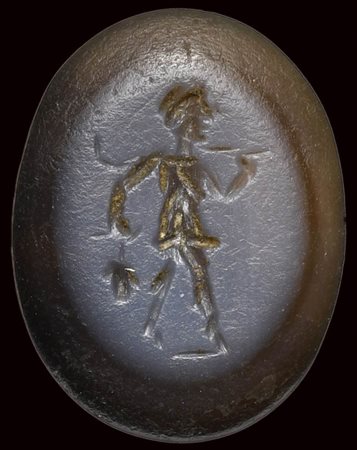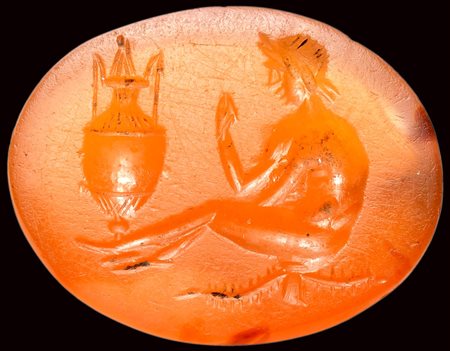Auction 86 - Glyptics and Ancient Jewelry
-

Lotto 145 A roman nicolo intaglio. Faun.
2nd - 3rd century A.D.
9 x 11 x 2,5 mm
The character advances to the right, holding a bunch of grapes and the pedum. Short groundline. Slight wear marks.
U.K private collection -

Lotto 146 A roman carnelian intaglio. Priapic scene.
2nd - 3rd century A.D.
9 x 12 x 3 mm
The standing male character is turned to the left and is depicted in the act of worshipping a priapean phallic herm. Apotropaic and votive scene referable to the cult of Priapus. Slight wear marks.
U.K private collection, London. -

Lotto 147 A roman nicolo intaglio set in an ancient gold ring. Faun.
2nd - 3rd century A.D.
intaglio : 10 x 13 mm
ring : 22 x 19 mm
9,17 g
Turned on the left, holding the pedum and offerings in his left hand. The intaglio is set on a large flatten hoop, ending on an large oval bezel decorated with 6 globules on each side.
U.K. private collection 1985. Formerly in Arthur Sambon (1867-1947) collection. -

Lotto 148 A roman carnelian intaglio mounted in a modern gold ring. Bucolic fight scene.
2nd-3rd century A.D.
Intaglio : 8 x 11 mm
Ring : 15 x 14 mm
4,74 g
Pan collides with a goat that throws itself against him, raising its anterior legs. A tree in left; below, a laurel wreath (symbol of victory) interrupts the groundline. Interesting work with an allegorical meaning. Slightly convex setting. Wear marks.
U.K private collection, London. -

Lotto 149 A romana agate intaglio. Satyr and a vase.
1st century B.C. - 2nd century A.D.
14 x 18 x 4 mm
The young naked figure is seated facing left, raising an arm as in the pose of contemplation. In front of him, an elegant amphora-shaped vase characterized by two handles with an acute angle (similar to the type of trozzella). An unusual double-ended attribute hangs from the satyr's genital area (similar to an insect). Apparently unpublished iconography, to be identified. Wear marks.
U.K private collection -

Lotto 150 A roman banded agate intaglio. Seated reader.
2nd century A.D.
10 x 13 x 3 mm
The character is seated on a crossed legs chair. He holds a papyrus near the face, reading it with attention.
Traces of iron mounting. Wear marks. Attractive color of the stone. Rare.
U.K private collection -

Lotto 151 A fine roman carnelian intaglio. Satyr with attributes.
1st century B.C. - 1st century A.D.
11 x 13 x 1 mm
The young satyr is standing with crossed legs, elegantly leaning against a column. The figure, inspired by the hellenistic models, is slightly three-quarters while the head is in profile. With his right hand he holds ribbons and a very gnarled curved stick (pedum) while with his left a large bunch of grapes. Small groundline. The intaglio is done with great technical and artistic skill. The pose is elegant and soft in the modeling of the anatomy. Attractive variety of stone zoned between light yellow and orange. Wear marks.
U.K private collection, London. -

Lotto 152 An unusual roman eight-layers banded agate cameo. Actor with mask and laurel wreath.
1st century B.C. - 1st century A.D.
7 x 9 x 3 mm
The elderly theatrical actor advances to the right, wearing a tunic skillfully engraved in the dark layer of the agate, unlike his body. With his left hand he holds a theatrical mask with the profile facing upwards, while with his left hand he holds a laurel wreath, symbol of victory and agonal triumph. This small cameo, expertly engraved on an unusual eight-layers agate, shows signs of wear and traces of a mounting on the edge. Rare and unpublished.
U.K private collection, London. -

Lotto 153 A roman nicolo intaglio. Athlete with herm.
1st - 2nd century A.D.
10 x 12 x 2 mm
The victorious character is standing, slightly in three quarters, with his right hand on his side and his left hand holding a laurel branch, a symbol of triumph. To his right, a bearded herm. Groundline. The muscular anatomy of the athlete is well engraved, according to a spontaneous sense of volumes. Attractive vivid color of the stone. Slight wear marks.
U.K private collection -

Lotto 154 A roman red jasper intaglio. Hephaestus.
1st - 2nd century A.D.
Intaglio : 9 x 11 mm Mounting : 12 x 18 mm
The character holds the tongs with his right hand, the hammer with his left. At his feet, a basket containing metal planchet-flan for minting coins (?). The figure wears a tunic and is characterized by the aspect of Hephaestus, with a thick beard and pileus headdres (a coin coiner?). Groundline. A black grain runs through the stone. Attractive vivid color of jasper. Fragmentary iron ring mounting. Rare iconography.
European private collection. -

Lotto 155 A roman carnelian intaglio. Cybele.
2nd-3rd century A.D.
12 x 15 x 3 mm
The syncretic figure is seated on the throne, wearing a tunic and a tourreted crown, holding a sceptre with the right hand, an attribute with the left. At her feet, lions. Cybele or Berecyntia, also known as Madre Montagna. Chips on the edge and traces of burns. Wear marks. Very rare.
Parallels:
Penn Museum database, inv. 29-128-908.
U.K private collection -

Lotto 156 A roman red jasper intaglio. Bust of Athena.
3rd century A.D.
10 x 13 x 2,5 mm
The helmated deity is turned to the left, wearing the egida. Slight wear marks and little trace of burning on the right.
U.K private collection -

Lotto 157 A large roman carnelian intaglio set in a gold ring. Bust of Athena.
2nd – 3rd century A.D.
Intaglio : 14 x 19 mm
Ring : 21 x 19,5 mm
17,43 g
Large rounded hoop ending with an oval bezel with the carnelian intaglio.
The goddess is turned on the left, represented with an helmet in a form of a mask showing wavy hair which gives a dimension of movement. The egides on her bust. Nice dimension of the stone and nice execution.
Small chip on the edge of the stone.
U.K private collection, London. -

Lotto 158 A roman three-layers onyx cameo. Athena.
2nd – 3rd century A.D.
11 x 16 x 7 mm
Helmeted bust of Athena. The goddess is depicted in profile, with the aegis. The gem is characterized by an high thickness. Very fine condition.
U.K private collection -

Lotto 159 A roman banded agate intaglio set in ancient gold ring. Bust of Helios.
2nd century A.D.
intaglio : 9 x 13 mm
ring : 20 x 19 mm
8,30 g
The solar god is turned on the left wearing the radiated crown. The intaglio is set in a large hoop, rounded without, flat within.
For the intaglio see parallels :
Antik Gemmen in Deutschen Sammlungen, Band IV, T.211, 1587, inv. K481
U.K. private collection 1985. Formerly in Arthur Sambon (1867-1947) collection. -

Lotto 160 A roman amethyst intaglio set in a large ancient gold ring. Bust of Artemis.
3rd century A.D.
Stone: 12 x 16 mm; ring diam. 18 mm; 12,22 gr.
With a large hollow hoop rounded without and flatten within, the broad shoulders ending with an oval bezel set with a large amethyst intaglio. The bust depicts the goddess Artemis facing left. She is characterized by a long neck and a rounded face with a proeminent chin. The semi-opened mouth is surmounted by a straight short nose. The large eye is framed with heavy lids and eyebrow and the pupil is incised. The short fronthead is surmounted by long weavy hair ending behind the neck with two large locks. The head adorned with a diadema. The bust is draped with an globular attach (fibula), behind, bow and arrows. The features treatment especially the eyes, nose and chin are characteristics of the near eastern workshops. The intact gold mouting shows traces of deposits and patina. Nice intense color of the stone.
U.K private collection, London. -

Lotto 161 A large roman eliotrope intaglio. Bust of Athena.
2nd - 4th century A.D.
16 x 22 x 5 mm
The helmeted divinity faces left and is depicted with a well-detailed bust decorated with a gorgoneion. Attractive variety of heliotrope, characterized by multi-colored inclusions. The stone is large in size and shows signs of wear on the entire surface.
U.K. private collection, London. -

Lotto 162 A roman rock crystal intaglio. Bust of Hercules.
2nd century A.D.
1,3 x 1,7 x 5 mm
The mythological hero is facing right and depicted with young features; plain chick, rounded chin, a long straight nose and a wide-open eye. The short fronthead is surmonted by a range of weavy hair, the rest covered by the head of a lion letting the ears uncovered. The details of the animal skin is well rendered, the crest hairs and the paws binding around the neck of the hero. Very fine execution and beautiful variety of rock crystal, with few inclusions. Wear marks.
U.K private collection, London. -

Lotto 163 A roman sard intaglio. Bust of Mercury.
1st B.C. - 1st century A.D.
11 x 13 x 2 mm
The young god face is presented on a light three-quarters. Caduceus behind the shoulder.Marked anatomical features. Slight wear marks.
U.K private collection -

Lotto 164 A roman carnelian intaglio. Female head.
2nd century A.D.
6 x 9 x 2 mm
Portrait of a young woman, turned to the left. Slight wear marks.
U.K private collection -

Lotto 165 A roman carnelian intaglio. Zeus Serapis.
1st century A.D.
16 x 17,5 x 4 mm
The bearded god is facing left, with a draped bust and a modius on the head. Slight wear marks and chipping on the edge. Attractive color of the stone.
U.K private collection -

Lotto 166 A roman red jasper intaglio. Allegory of Zeus.
2nd - 3rd century A.D.
13 x 16 x 3 mm
Above, the bust of Zeus Serapis facing left, below the eagle with open wings; on the sides, military banners surmounted by winged victories. Allegory of the military and political power of the Empire. Well composed subject. Slight signs of wear.
Parallel: Antiken Gemmen in Deutschen Sammlungen, Band I, Staatliche Munzsammlung Munchen, Teil 3, p. 86 n. 2667
U.K private collection, London. -

Lotto 167 A roman agate cameo. Four conjoined heads (Janus).
1st century B.C. - 2nd century A.D.
14 x 16 x 5 mm
In the foreground, the typical two-faced bust of Janus characterized by two conjoined bearded heads. In the background there are two other conjoined bearded heads, seen in profile: two overlapping pairs of joint heads. The iconography is inspired by the apotropaic compositions of the gryllos and the carvings with vases covered by conjoined human heads. The model for the double-faced bust of Janus comes from the Roman republican coinage (see : Anonymous. Circa 225-217 BC. Æ Aes Grave As). Wear marks. Large chippings on the backside of the stone. Unusual specimen. Rare iconography.
U.K private collection -

Lotto 168 A roman red jasper intaglio. Bust of ephebus.
2nd century A.D.
10 x 13 x 2 mm
The young man is turned on the left side. The head is characterized with long thick hair covering the ears. Attractive stone color. Little chipping on the edge.
U.K private collection
